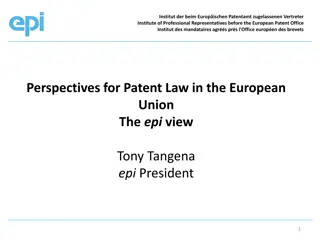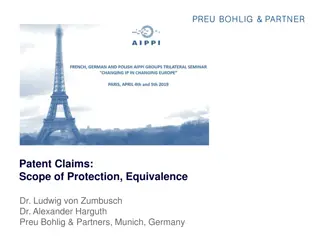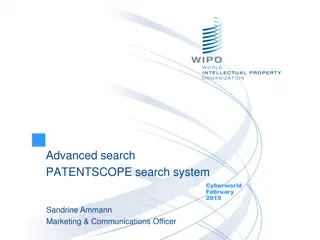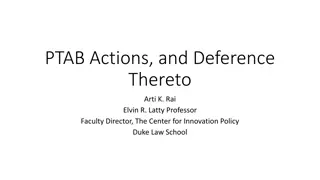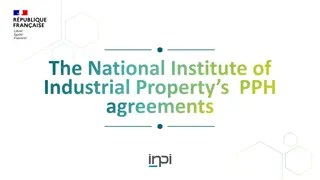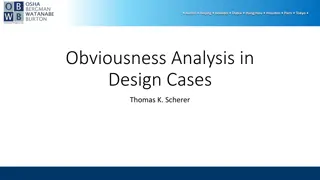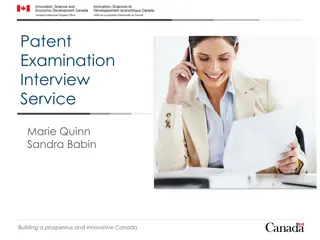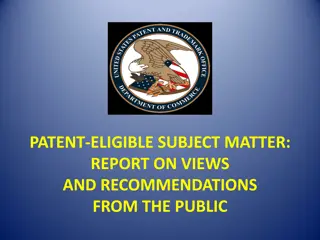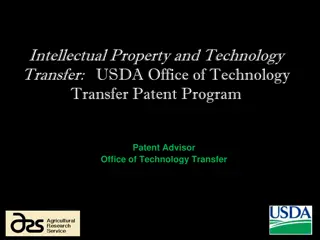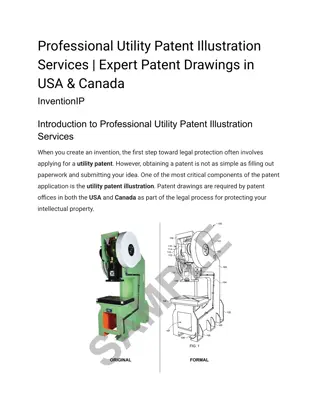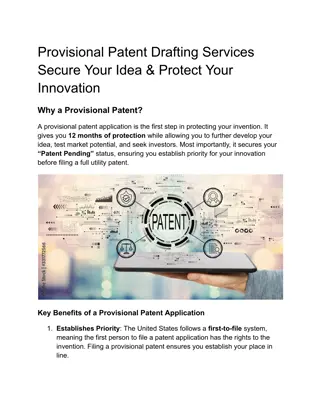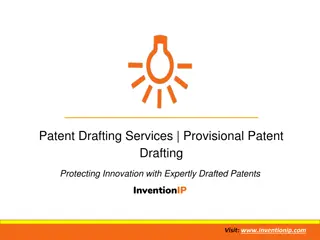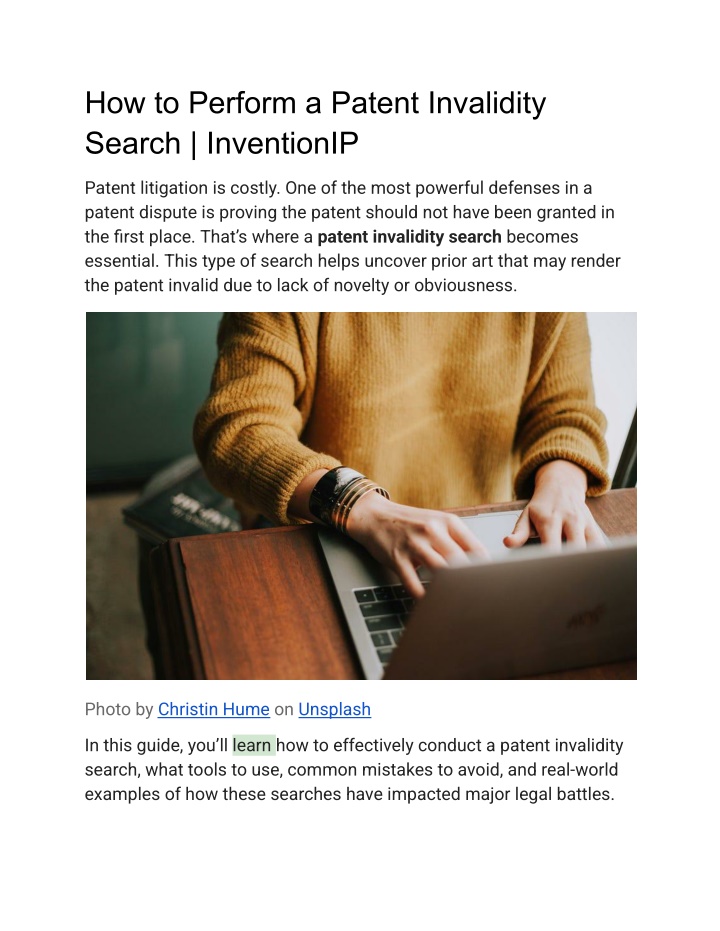
How to Perform a Patent Invalidity Search | Step-by-Step Guide | InventionIP
Discover how to perform a comprehensive patent invalidity search with this detailed guide. Learn how to break down patent claims, identify key features, locate relevant prior art, and create effective invalidity charts. Includes expert tips, advanced
Uploaded on | 2 Views
Download Presentation

Please find below an Image/Link to download the presentation.
The content on the website is provided AS IS for your information and personal use only. It may not be sold, licensed, or shared on other websites without obtaining consent from the author. If you encounter any issues during the download, it is possible that the publisher has removed the file from their server.
You are allowed to download the files provided on this website for personal or commercial use, subject to the condition that they are used lawfully. All files are the property of their respective owners.
The content on the website is provided AS IS for your information and personal use only. It may not be sold, licensed, or shared on other websites without obtaining consent from the author.
E N D
Presentation Transcript
How to Perform a Patent Invalidity Search | InventionIP Patent litigation is costly. One of the most powerful defenses in a patent dispute is proving the patent should not have been granted in the first place. That s where a patent invalidity search becomes essential. This type of search helps uncover prior art that may render the patent invalid due to lack of novelty or obviousness. Photo by Christin Hume on Unsplash In this guide, you ll learn how to effectively conduct a patent invalidity search, what tools to use, common mistakes to avoid, and real-world examples of how these searches have impacted major legal battles.
What Is a Patent Invalidity Search? A patent invalidity search is a focused effort to locate existing documents or publications (prior art) that show a patented invention is not novel or is obvious in light of earlier technology. This search can be used to challenge the enforceability of a patent in court or before the patent office. Unlike novelty searches done before filing a patent, invalidity searches are performed after a patent is granted, often in response to: Patent litigation Infringement claims Licensing negotiations Mergers and acquisitions The goal is clear: to find documentation that proves the patent should not have been granted. Why Is an Invalidity Search Important? A single invalid patent can block innovation, cost companies millions in legal fees, and grant monopolies that aren t deserved. Invalidity searches help prevent this by: Avoiding unnecessary litigation Supporting defense in patent infringement lawsuits Reducing settlement costs Strengthening negotiation positions Preventing licensing of weak patents
Example: In Apple v. Samsung, Samsung used prior art to argue that Apple s design patents lacked novelty. The prior art didn t fully invalidate Apple s patents, but it significantly reduced the damages awarded. When Should You Conduct an Invalidity Search? Timing matters. Conduct a patent invalidity search when: You receive a cease and desist letter You re facing patent litigation You re planning to challenge a competitor s patent You re considering acquiring or licensing a patent You re preparing for post-grant proceedings, like IPR (Inter Partes Review) Early invalidity analysis can shape your legal strategy and give your legal team critical leverage. Step-by-Step Guide to Performing a Patent Invalidity Search 1. Analyze the Patent Claims Carefully The first step is to read the patent claims thoroughly. Focus on independent claims, as they define the broadest scope. Each element in the claim must be accounted for when searching for invalidating prior art. Tip: Look for claim language that could be interpreted broadly. These areas are more vulnerable to attack.
2. Break Down the Claims into Key Elements Dissect each independent claim into individual components or features. This breakdown will help you identify what must be matched in the prior art. Example: If the claim is for a wireless smart lock with biometric access and mobile app control, break it down into: Wireless communication Biometric access Mobile app control 3. Identify the Priority Date Check the patent s filing and priority date. Any prior art must be published before this date to count in your search. Tip: Use the earliest priority date if the patent claims benefit from an earlier provisional or foreign filing. 4. Search for Prior Art in Patent and Non-Patent Literature Search both patent databases and non-patent literature (NPL), including: Scientific journals Engineering white papers Product catalogs YouTube tutorials Archived websites
Conference proceedings Databases to Use: Google Patents USPTO Full-Text Search Espacenet The Lens IEEE Xplore ScienceDirect Archive.org (Wayback Machine) 5. Use Strategic Search Techniques Employ advanced search operators: Boolean operators (AND, OR, NOT) Wildcards Proximity search CPC/IPC classification codes Example: To find prior art for a smart thermostat, try searching: ("smart thermostat" OR "intelligent thermostat") AND ("Wi-Fi" OR "remote control") AND ("temperature sensor") 6. Evaluate Each Reference for Relevance Not every match is valid prior art. Ensure the reference: Was publicly available before the patent s priority date
Discloses all elements of the claim Does not combine unrelated teachings unless obvious to someone skilled in the art Note: A single reference is best, but a combination of multiple documents may also be used. 7. Create an Invalidity Chart Map out each element of the claim to corresponding passages in the prior art. This structured comparison strengthens your legal argument. Include: Claim language Prior art citation Excerpts with exact page and line references Your analysis of why it matches 8. Seek Legal Review A registered patent attorney or agent should review your findings. They can: Confirm the legal weight of the prior art Prepare formal invalidity contentions Advise on potential litigation strategy
Case Study: Invalidity Search That Changed the Game Case: Netflix v. Rovi (now Xperi) Rovi accused Netflix of infringing several patents related to content recommendations. Netflix s legal team conducted an extensive invalidity search and found prior art from early academic papers and television manuals. As a result, the Patent Trial and Appeal Board (PTAB) invalidated key Rovi patents, and Netflix won the case. Impact: Netflix avoided paying licensing fees and established a stronger position against future patent threats. Common Mistakes to Avoid Ignoring non-English references: Valuable prior art may be published in other languages. Relying only on keywords: Use classification searches and synonyms. Overlooking public disclosures: Presentations, blog posts, or user manuals can be valid prior art. Missing claim limitations: All claim elements must be addressed. Additional Tips for Better Results Use date filters to focus on publications before the priority date. Check expired patents, older filings often contain overlooked gems.
Dont forget obscure databases like CNIPA (China) or J-PlatPat (Japan). Document your search terms and logic to ensure transparency. FAQs About Patent Invalidity Searches Q: Can a single document invalidate a patent? Yes, if it discloses all claim elements and is dated before the priority date. Q: What if I find multiple documents that together disclose the invention? You can combine references, but they must be logically connected and obvious to someone skilled in the art. Q: Is an invalidity search legally binding? The search itself isn t binding, but it provides the evidence needed to challenge a patent in court or through the USPTO. Q: What s the difference between anticipation and obviousness? Anticipation requires a single prior art reference to disclose everything. Obviousness allows combining references that collectively show the invention would have been obvious. Q: How long does it take? Expect 2 4 weeks for a high-quality search, depending on complexity. Q: Can I do it myself? Technically yes, but due to legal implications, it s highly recommended to use a professional search firm and legal counsel.
Conclusion A patent invalidity search is a strategic tool for protecting your business and challenging questionable patents. When performed correctly, it can expose prior art that weakens or completely destroys a patent s legal enforceability. Whether you re facing litigation, defending your product, or analyzing a competitor s IP, an invalidity search can give you the upper hand. Get Expert Help Now Ready to perform a professional, reliable patent invalidity search? Let the experts at InventionIP handle it for you. Protect your innovation and stay ahead of potential patent threats with confidence.



